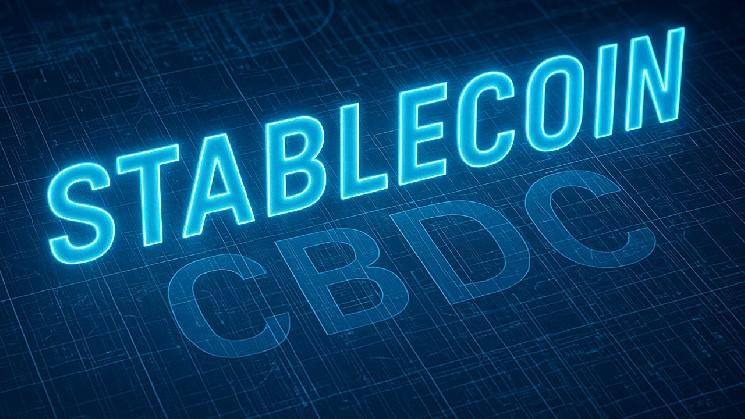CBDC in Plain Sight: Are Stablecoins the Hidden Blueprint for a United States Digital Dollar?
Stablecoins, digital currencies pegged to the U.S. dollar, have surged in popularity, but their quiet strength under slim regulatory scrutiny might signify a deeper function as a testing room for a reserve bank digital currency (CBDC). These blockchain-based tokens, created to keep a steady value, provide a glimpse into a future where federal governments might leverage their infrastructure to introduce a state-controlled digital dollar.
Stablecoins and the Quiet Increase of a Central Bank Digital Dollar
As the U.S. comes to grips with the implications of a CBDC, stablecoins like Tether’s USDT and Circle’s USDC, which have thrived with relatively minimal government interference, raise questions about whether they are unintentional models for a wider, more centralized financial transformation. Stablecoins operate on a simple premise: they are cryptocurrencies tied to a fiat currency, usually the U.S. dollar, to avoid the volatility affecting assets like bitcoin or ethereum. Issued by private companies, they are backed by reserves of cash, bonds, or other assets, ensuring a 1:1 peg with the dollar. Tether’s USDT, the largest stablecoin, and USDC, issued by Circle, dominate the market, facilitating billions in daily transactions across decentralized finance (DeFi) platforms, remittances, and global trade.
The U.S. government has long shown interest in a CBDC, a digital version of the dollar issued and managed by the Federal Reserve. Unlike stablecoins, a CBDC would be a direct liability of the central bank, offering unparalleled control over monetary policy, transaction tracking, and financial oversight. Advocates argue it could enhance payments, reduce costs, and improve financial inclusion. Critics, however, warn of privacy erosion, surveillance risks, and the potential for governments to exert unprecedented control over individual spending.
The Biden administration’s 2022 executive order on digital assets tasked agencies with exploring CBDC feasibility, and the Federal Reserve has been assessing its implications through initiatives like Project Hamilton. However, launching a CBDC from scratch is a monumental task—unless the infrastructure already exists. Enter stablecoins, which have quietly laid the groundwork for a digital dollar. Their blockchain networks, wallet systems, and integration with global exchanges provide a ready-made ecosystem. Tether and USDC, for example, operate on public blockchains like Ethereum, enabling seamless, near-instantaneous transactions across borders. They have also navigated regulatory gray areas since their inception.
The Role of Stablecoins in Shaping a Potential CBDC
The parallels between stablecoins and a potential CBDC are striking. Both rely on digital ledgers to track transactions, both aim for dollar parity, and both necessitate trust in the issuer’s backing. A CBDC could potentially adopt a stablecoin’s architecture, substituting private companies for the Federal Reserve. This transition could serve as a covert strategy, circumventing the need to develop a CBDC from the ground up. By leveraging existing stablecoin frameworks, the Fed could roll out a digital dollar with minimal disruption, utilizing familiar technology to ease public and institutional adoption.
Some critics speculate that the GENIUS Act could pave the way for a CBDC by establishing a framework for banks to issue dollar-pegged stablecoins that mimic the functionalities of a state-controlled digital dollar. This could enable government oversight and control without direct Federal Reserve issuance. By authorizing federally chartered banks to issue stablecoins under stringent regulatory oversight, the Act might create an interoperable network of private digital currencies mirroring CBDC capabilities.
Challenges and Opportunities of a CBDC Built on Stablecoin Foundations
A CBDC developed on stablecoin infrastructure could grant the Federal Reserve unprecedented visibility into transactions, potentially necessitating digital wallets linked to verified identities. Unlike cash, which offers anonymity, a CBDC could trace every dollar’s movement, raising privacy concerns. Stablecoins currently collect user data through exchanges and wallet providers, a practice that could expand under a CBDC. A central bank could configure a CBDC to enforce policies—such as negative interest rates or spending restrictions—directly impacting how individuals utilize money. The smart contract capabilities of stablecoins, enabling programmable transactions, could serve as a template for such controls.
While skeptics may argue that stablecoins are too decentralized to serve as CBDC prototypes, overlooking the central control points, a CBDC could preserve blockchain efficiency while replacing private issuers with the Fed, centralizing governance. The government might mandate interoperability between stablecoins and a prospective CBDC, forging a hybrid system where private tokens pave the way for state authority.
The Global Context and Strategic Implications
Amid China’s trials with the digital yuan and the launch of CBDCs in countries like the Bahamas and Nigeria, the U.S. faces the risk of lagging behind in shaping the future of money, especially as stablecoins like Tether dominate cross-border payments in regions with volatile currencies. By integrating stablecoin infrastructure into a CBDC, the U.S. could uphold the dollar’s international dominance while countering foreign digital currencies, presenting a strategic advantage that may explain regulators’ tolerance of stablecoin growth.
Public perception poses a challenge. While stablecoins enjoy trust among crypto users, a CBDC could encounter resistance over surveillance apprehensions. The government could mitigate this by framing a CBDC as an evolution of stablecoins, emphasizing familiarity and reliability. The transparency and reserve backing of a popular dollar coin could reassure users that a digital dollar is equally trustworthy. Conversely, stablecoin entities may welcome integration as it could solidify their position in a government-sanctioned system, shielding them from future regulatory crackdowns.
Conclusion: The Path to a CBDC Through Stablecoin Innovation
The journey toward a CBDC is fraught with technical and political hurdles, yet stablecoins present a compelling shortcut. Their widespread adoption, battle-tested infrastructure, and regulatory endurance over the past decade position them as ideal candidates for a covert transition. As the Federal Reserve edges closer to a CBDC, the distinction between private stablecoins and state-controlled currency blurs, prompting a critical question: Are we already witnessing the blueprint for the future of money?


